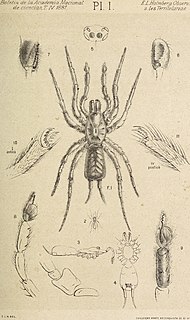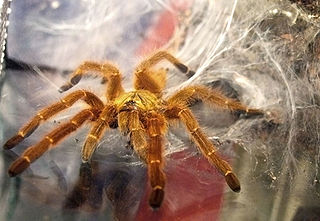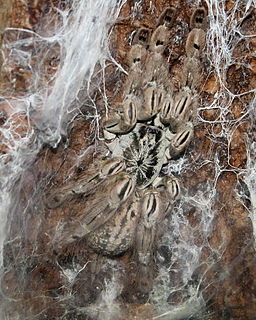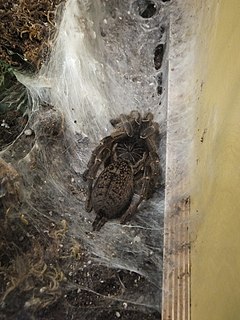
The Araneomorphae are an infraorder of spiders. They are distinguished by having chelicerae (fangs) that point diagonally forward and cross in a pinching action, in contrast to the Mygalomorphae, where they point straight down. Most of the spiders that people encounter in daily life belong to the Araneomorphae.

Atypidae, also known as atypical tarantulas or purseweb spiders, is a spider family containing only three genera. They are accomplished ambush predators that spend most of their time in a sock-like, silken retreat on the ground from where they kill their prey.

The Goliath birdeater belongs to the tarantula family Theraphosidae. Found in northern South America, it is the largest spider in the world by mass – 175 g (6.2 oz) – and body length – up to 13 cm (5.1 in) – but it is second to the giant huntsman spider by leg span. It is also called the Goliath bird-eating spider; the practice of calling theraphosids "bird-eating" derives from an early 18th-century copper engraving by Maria Sibylla Merian that shows one eating a hummingbird. Despite the spider's name, it only rarely preys on birds.

Lasiodora parahybana, the Brazilian salmon pink bird-eating tarantula, also simply known as the salmon pink or LP, is a tarantula from north-eastern Brazil and considered to be the third largest tarantula in the world.

Dwarf tarantulas, also known as sheet funnel-web spiders are a type of spider from the family Mecicobothriidae. Dwarf tarantulas are one of several families of the suborder Mygalomorphae; this larger group also includes the true tarantulas.

The Harpactirinae are a subfamily of tarantulas which are native to the continent of Africa. Like many Old World tarantulas, they have a relatively strong venom, and can inflict a painful bite.

Pterinochilus is a genus of baboon spiders that was first described by Reginald Innes Pocock in 1897.

Pterinochilus murinus is an old-world tarantula that was first described in 1897 by Reginald Innes Pocock. This species is found on the African continent, in Angola, as well as central, eastern, and southern Africa. It is a member of the subfamily Harpactirinae, baboon spiders.

Ceratogyrus is a genus of tarantulas found in southern Africa. They are commonly called horned baboons for the foveal horn found on the peltidium in some species. They are readily distinguished from other African theraphosid genera by the combined presence of a retrolateral cheliceral scopula, composed of plumose, stridulatory setae, and the strongly procurved fovea. The fovea is typically strongly procurved and in some species surrounds a distinct protuberance. this protuberance may take the form of a simple posterior extension of the caput, a low-set plug or a prominent, discrete conical projection. All Ceratogyrus species possess a pale yellow anteriorly placed, transverse, sub-abdominal band. This feature is not distinct in other Harpatirinae except Augacephalus junodi. The absence of dense, ventral femoral fringes on the palpi and legs I and II distinguish Ceratogyrus spp. from female A. junodi.

Ceratogyrus darlingi is a theraphosid spider from southern Africa, mainly Botswana and Lesotho. They reach a body length of about 5 inches (130 mm) and are ash-gray, mud-brown to black. The peltidium features a black foveal horn.
Ceratogyrus brachycephalus is an old world terrestrial tarantula that grows to a legspan of up to 5 inches (12 cm). The common name comes from the "horn", or protuberance, on the carapace.

Poecilotheria regalis is a species of arboreal tarantula and is found in parts of India. The common name for this spider is Indian ornamental tree spider, or simply Indian ornamental. It is one of the most popular arboreal tarantulas for amateur collectors. Their leg span sometimes exceeds 7 inches (18 cm).

Tarantulas comprise a group of large and often ″hairy″ spiders of the family Theraphosidae. Currently, about 1,000 species have been identified. The term tarantula is usually used to describe members of the family Theraphosidae, although many other members of the same infraorder (Mygalomorphae) are commonly referred to as "tarantulas" or "false tarantulas". Some of the more common species have become popular in the exotic pet trade. Many New World species kept as pets have urticating hairs that can cause irritation to the skin, and in extreme cases, cause damage to the eyes.
Hysterocrates gigas is a member of the tarantula family, Theraphosidae found in Cameroon. It is known as the giant baboon spider, Cameroon red baboon spider, or red baboon tarantula.

The skeleton tarantula, Ephebopus murinus, is a species of spider belonging to the family Theraphosidae (tarantulas), sub-family Aviculariinae. A New World species, it is native to several South American countries. Its common name is derived from the skeleton-like markings on its legs.

Aphonopelma anax, commonly known as the Texas tan tarantula, is a species of spider belonging to the family Theraphosidae native to southern Texas and northern Mexico.

Heteroscodra maculata is an Old World species of tarantula which was first described in 1899 by Reginald Innes Pocock. This species native to West Africa and is found primarily in Togo and Ghana. This species has many common names, of which Togo starburst and ornamental baboon are most frequently encountered.

Ceratogyrus meridionalis, commonly known as the Zimbabwe grey baboon tarantula or the grey mustard baboon, is a species of tarantula. It is found in Malawi and Mozambique.
Ceratogyrus marshalli, also known as straight horned baboon or great horned baboon, is a species of tarantula from the genus Ceratogyrus. It is found in Zimbabwe and Mozambique.















